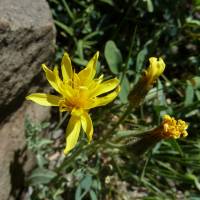Annuals, biennials, or perennials, 3-120 cm; usually taprooted, sometimes rhizomatous (roots deep or shallow, woody or fibrous, caudices often woody). Stems 1-20+. erect to decumbent. simple (sometimes scapiform) or branched, usually striate, glabrous or hairy, often densely hispid or setose (hairs often stipitate-glandular). Leaves basal (often in rosettes) and cauline; petiolate (at least basal, petioles ± winged); basal blades mostly elliptic, ovate, or lanceolate to linear, or spatulate to oblanceolate, often lyrate or runcinate, margins entire, dentate, serrate, toothed, or pinnately lobed, lobes sometimes toothed; cauline usually present, lobed or entire, usually reduced in size and lobing distally. Heads (erect) usually in cymiform, corymbiform, or paniculiform arrays, sometimes borne singly. Peduncles not inflated distally, not bracteate. Calyculi of 5-12, reduced, subulate to lanceolate or deltate bractlets in ± 1 series, mostly unequal, glabrous, tomentulose, or setose. Involucres cylindric to campanulate (sometimes becoming turbinate in fruit), 4-15 mm diam. Phyllaries 5-18 in 1-2 series. lanceolate, equal or subequal, (bases becoming thickened and keeled, keels sometimes pronounced in fruit) margins green to yellowish, often scarious, apices acute to acuminate, abaxial faces glabrous, tomentose, or setose, sometimes stipitate-glandular, adaxial glabrous or with appressed hairs. Receptacles flat or convex, usually pitted, glabrous or hairy, epaleate [paleate, paleae narrow, thin]. Florets 5-100+; corollas usually yellow or orange, sometimes white, pink, or reddish. Cypselae monomorphic or dimorphic. yellow, brown, green, red, and/or black, subcylindric or fusiform, terete or subterete, usually curved, apices tapered or beaked, ribs 10-20, sometimes spiculate-roughened, faces glabrous or hispidulous; pappi persistent or falling, of 80-150, usually distinct, sometimes basally connate, white to tawny, coarse to fine, ± equal (or outer shorter), barbellulate bristles in 1-2 series. x = 3, 4, 5, 6, 11.
Crepis is generally recognized by the rosettes of coarse, often pinnately lobed leaves, erect heads, epaleate receptacles, calyculate involucres. yellow corollas, subcylindric or fusiform, ribbed cypselae, and pappi of barbellulate bristles. The taxonomy and evolutionary relationships of Crepis were studied by E. B. Babcock (1947) and his associates. Their work was thorough and important because of the effort to incorporate cytogenetic information in the evolutionary analysis. Extensive survey of chromosome number and karyotype indicated two major ploidy groups in Crepis, corresponding to New World and Old World species complexes. Of the 12 species of Crepis native to North America, 10 are polyploids with x = 11. The core diploid populations commonly occupy discrete ecologic zones and are thought to be entirely distinct from one another, yet they are interconnected by a continuous complex series of intergrading polyploid forms that are partly or completely apomictic (Babcock). The polyploids are of two forms, autopolyploids that are similar to the diploids, and allopolyploids that combine the characteristics of two or more diploid species. The allopolyploid forms of hybrid origin may exhibit the characteristics of multiple parental species and therefore are difficult to classify. Some of the heterogeneous apomictic populations, or groups of populations, have been grouped together and recognized as subspecies; those taxa are often difficult to identify and further study is clearly needed. Despite these difficulties, the subspecific taxa of Babcock were tentatively included in the present study. The Old World species are mostly diploid (n = 3, 4, 5, or 6). Babcock concluded that there was a progressive decrease in the chromosome numbers, from n = 6 to n = 3. Along with the decrease is a corresponding increase in chromosome asymmetry and reduction in chromosome length.
Fls all ligulate and perfect, yellow; invol cylindric or campanulate, the principal bracts in 1 or 2 equal or subequal series, the reduced outer ones few or many; receptacle naked; achenes terete or subterete, fusiform or nearly columnar, sometimes beaked, 10-20-ribbed; pappus of numerous whitish capillary bristles; herbs with milky juice, mostly (incl. all our spp.) taprooted or with several strong roots; lvs alternate, entire to bipinnatifid, ±basally disposed, the cauline progressively reduced, the uppermost bract-like. Nearly 200, N. Hemisphere.
Gleason, Henry A. & Cronquist, Arthur J. 1991. Manual of vascular plants of northeastern United States and adjacent Canada. lxxv + 910 pp.
©The New York Botanical Garden. All rights reserved. Used by permission.










